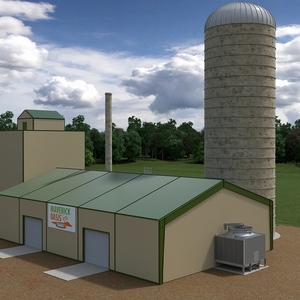Maverick Synfuels introduces modular GTL methanol plants

Photo: Maverick Synfuels
September 23, 2014
BY Maverick Synfuels
Maverick Synfuels, a leader in alternative chemicals and fuels production technology, has introduced the first small-scale, modular methane-to-methanol production plant that can be co-located at the methane source. The trademarked Maverick Oasis system allows producers to monetize biogas and natural gas (including associated or flare gas, and stranded gas reserves), as an alternative to producing electricity or venting destructive greenhouse gases into the atmosphere.
The Maverick Oasis factory-built gas-to-liquids (GTL) methanol plants are modular, and can be rapidly deployed onsite to produce thousands of gallons per day of ultra-clean methanol from natural gas or methane-rich waste gas. The plants are designed to be low-cost, highly efficient facilities optimized to generate an attractive project rate of return. Each Oasis modular facility comes equipped with performance guarantees based on the designed methanol output rating.
The Maverick Oasis system uses proprietary technology to convert a variety of methane-containing feedstocks—including biogas, natural gas (including stranded gas and flare gas), coal bed methane, and landfill gas—into AA grade methanol that meets ASTM D1152 specifications.
With a footprint of just 5,000 square feet, each plant is modular so that it can be shipped to the operational location, where it is assembled by a team of Maverick engineers and integrated with the local infrastructure.
Each modular facility will produce between 3,000 and 10,000 gallons per day of methanol that is consumed onsite or transported to nearby markets. By using standard assembly line manufacturing processes, Maverick Oasis significantly reduces the capital requirements and delivery time (nine to 12 months) compared to larger plants that must be built on site.
Advertisement
Advertisement
“At this scale, the Maverick Oasis system is the first commercially proven technology that converts low-value gas feedstocks into methanol and higher-value products,” said Jeff Harrison, Maverick’s chief engineering officer.
Maverick Oasis is feedstock flexible and can be located at the feedstock source:
Agriculture Digesters: For dairy farms, waste water treatment plants, and other facilities that use anaerobic digesters to process animal, food, and other organic waste, Maverick Oasis offers more vertical integration with clean fuel products and an alternative to traditional electricity generation.
Landfill Methane Collection: Maverick Oasis provides another use for methane that would either be flared or vented into the atmosphere, and the methanol that is produced provides a higher value return than typical electricity generation.
Oil and Gas Fields: Maverick Oasis takes advantage of both stranded natural gas reserves and associated (flare) gas found when drilling for petroleum.
Advertisement
Advertisement
“For the first time, Maverick Oasis brings proven GTL technology to smaller gas reserves in an efficient, compact and modular configuration,” said Sam Yenne, Maverick’s CEO. “With Maverick Oasis, these gas reserves can be converted into methanol, a transportable product which is a highly valued commodity, and which can be used directly or converted to other fuels like clean diesel, jet fuel, and higher-value products. In addition to reducing greenhouse gas emissions, Maverick Oasis will bring jobs and other economic benefits to many rural locations.”
Converting methane gas to liquid methanol is one component of Maverick’s “spoke and hub” distributed production strategy that builds on the company’s patented, trademarked Olefinity technology.
In the future, methanol produced at Maverick Oasis “spokes” located at the waste gas source is easily transportable to larger “hub” facilities, where it can be converted to higher value products such as clean transportation fuels, including dimethyl ether, diesel and jet fuel, or specialty chemicals like propylene using Maverick’s olefins based processes.
Methanol is an important intermediate for producing high-value products, including olefins, acetic acid, formaldehyde, plastics, resins, and other chemical products in addition to being used to produce biodiesel, to prevent hydrate formation, and to denitrify waste water.
In some markets, methanol can be blended with gasoline (M15, M85) or used directly as M100. Methanol can also be used in fuel cells or further synthesized into dimethyl ether (a diesel and LPG substitute), diesel and jet fuel. Methanol blends make environmentally superior fuels that improve combustion, burn cleanly, and reduce emissions.
Maverick is pursuing opportunities to build and operate the Maverick Oasis platform, and is interested in having discussions with potential strategic partners.
Upcoming Events





